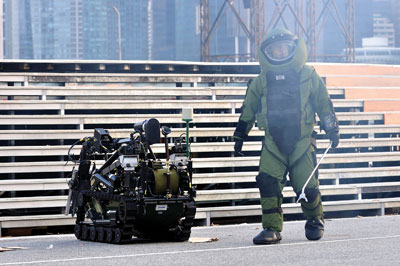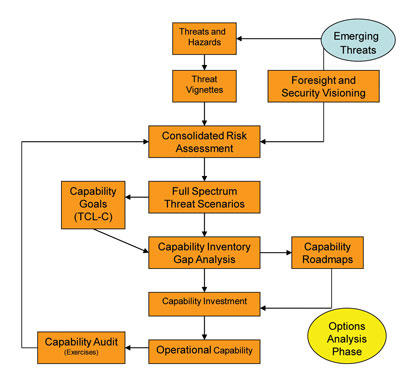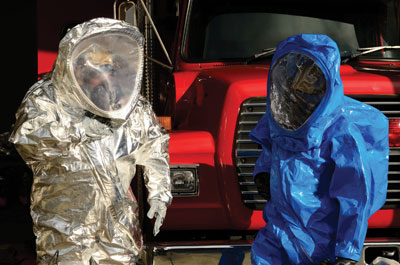
Features
Hot topics
Response
Capability-based planning
In a post-911 world the fire officer is faced with the routine fire calls, hazmat spills, and now, an increased potential for a chemical, biological, radiological, nuclear, and explosive (CBRNE) event.
April 20, 2012
By Barry Bouwsema
In a post-911 world the fire officer is faced with the routine fire calls, hazmat spills, and now, an increased potential for a chemical, biological, radiological, nuclear, and explosive (CBRNE) event. The threat of a terrorist attack needs to be considered by all front line first responders. If this a concern for you, read on.
 |
|
| The consolidated risk assessment is an integral component of the new CRTI (CBRNE Research Technology Initiative) Science and Technology investment model and is used to identify and assess threats and corresponding risks across all mission areas of prevent, prepare, respond, and recover.
|
To help you, the Canadian Centre for Security Science has developed new methodology in risk assessments, built on best practices in the emergency-management community. The Canadian Centre for Security Science is participating in a joint endeavour with Public Safety Canada to provide science and technology services for national public safety and security.
Through this initiative, future trends and threats are identified, and support and services are provided for all-hazards vulnerability and risk assessment, technology forecasting and operational analysis.
For the fire officer, this research allows for the co-ordination and implementation of fire-suppression operations, which include the following tasks:
- assessing the scene
- assigning resources
- establishing an incident-command system (ICS) consistent with the command system used by the authority having jurisdiction (AHJ)
- communicating the status of the situation
- requesting additional resources
- establishing a safe perimeter
- evacuating persons in danger
- rescuing trapped victims
- conducting fire suppression
- determining the cause of the fire(s)
- ensuring the area is left in a safe condition.
This capability further includes support necessary to prepare the community and reduce vulnerabilities in the event of a major event.
Routinely, at fire scenes, the first unit to arrive initiates the ICS, assesses the incident scene, communicates the situation, and requests appropriate resources including any necessary mutual aid or cross-discipline support. Firefighting activities are conducted safely and fire hazards and environmental concerns are contained, controlled, extinguished, and investigated, and the incident is managed in accordance with emergency-response plans and procedures. Many of these activities already occur on fire grounds all over Canada; what capability-based planning (CBP) provides is the mechanism to monitor whether benchmarks are being met and resources and capabilities are adequate for the task at hand. If not, CBP provides a means to quantitatively prove that a gap in service level exists that needs to be addressed.
 |
|
| The capability-based planning model
|
The consolidated risk assessment (CRA) process as one of the first steps in the CBP methodology can be used to quantify risk and help direct your department’s future investment strategies. The CRA is an integral component of the new CRTI (CBRNE Research Technology Initiative) Science and Technology investment model and is used to identify and assess threats and corresponding risks across all mission areas of prevent, prepare, respond, and recover. This style of risk-assessment template is used for assessing the risk associated with threat scenarios across five categories that cover all hazards: terrorism, intentional, accidental, technological, and natural. The combination of these threat categories into a common framework is increasingly beneficial as assessments proceed from a national to a local level. The CRA is a process that engages experts from law enforcement, intelligence, first-responder communities and emergency-planning stakeholders, to name just a few.
The process builds consensus on vulnerabilities, threat issues, and their associated risks. The following objectives are integral to the CRA process as it pertains to the CRTI:
- To provide a measure of risks that may be used to study corresponding gaps;
- To provide a sense of immediacy and prioritization for addressing existing and potential threats and corresponding gaps;
- To serve as a key indicator in the formulation of science and technology investment priorities;
- To serve as a planning and investment priority setting method.
The CRA process focuses on threats and hazards for your organization and/or region. Following the CRA step, a full-spectrum scenario is developed to provide a context against which to measure the level of capability and provide a basis for developing goals against which the organizational capabilities are assessed. A capability inventory gap analysis is then conducted to identify gaps between the risks to the organization/region and the capability to respond to the risk. These identified gaps in the missions of prevent, prepare, respond, and recover are closed using the options analysis phase, in which plans are developed to correct the identified deficiencies. The CBP process focuses on systems and multiple services capability versus single-service silos; CBP connects the capabilities to strategic requirements for problem mitigation. The CBP risk model identifies performance gaps and generates a performance-management framework to address the shortage of resources in a cost-effective manner. The CBP process allows risk to be evaluated from a quantitative-assessment approach, which allows for ranking and scalability. It applies sound research methods in the assessment of risk. The ranking process allows for prioritization of investment in deciding how the identified capability gaps should be filled, to minimize or eliminate the threats to the community.
 |
|
| Specifically for the firefighting and hazmat first responder community, the target capabilities of onsite incident management, fire incident response, CBRNE, and hazardous-materials response and decontamination are addressed by the capability-based planning process.
|
The capability inventory gap analysis step involves the use of target capability lists. Specifically for the firefighting and hazmat first responder community, the target capabilities of on-site incident management, fire incident response, CBRNE and hazardous-materials response and decontamination are addressed by the capability-based planning process. The use of these target capabilities during the CBP process gives a clear understanding of assets and capabilities that the region has for response to a potential threat, such as a fire/hazmat incident. The CBP process also helps to determine the best solutions for closing capability gaps, and provides a method for measuring the effectiveness of the risk-reduction investment. The use of the CBP process and the associated target capabilities allows for a common language to share task assignments across professions, and a common system to conduct capability inventories and gap analyses for their cities, regions, or provinces.
For example, having a common understanding with your mutual-aid partners during a large-scale event is critical to a successful outcome; this is where the CBP process can help your service.
The CBP process is an emerging trend in emergency management for Canada. This methodology enables first-responder organizations to better prepare and execute a co-ordinated response to incidents within their jurisdiction, as better science will lead to better decision making for first-responder organizations that need to deal with emergencies involving fire, hazmat, or CBRNE calls.
For more information visit www.cdn-cpb.org
Print this page